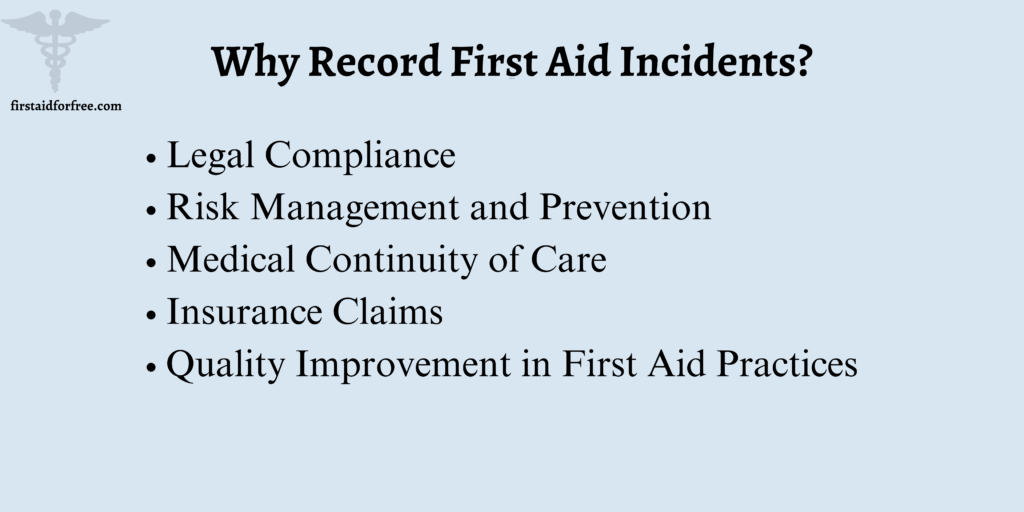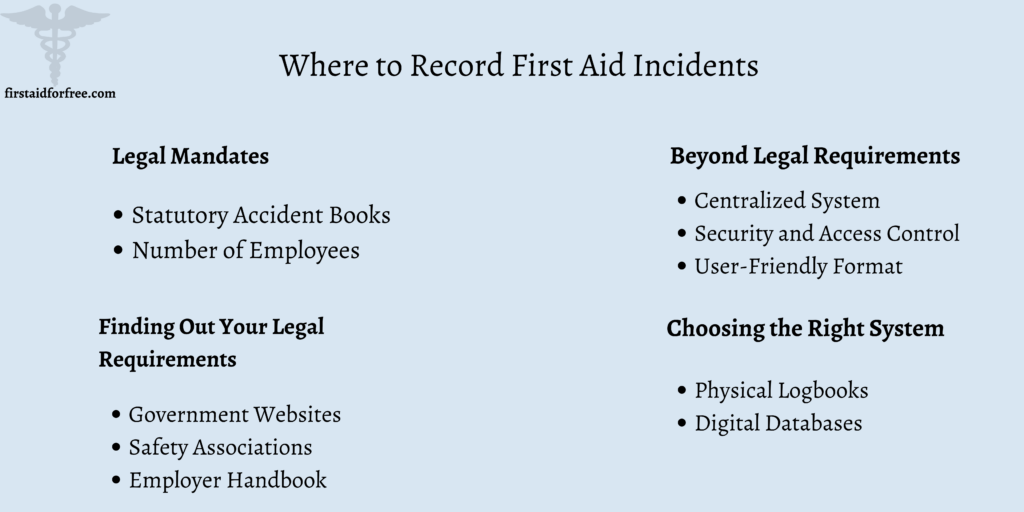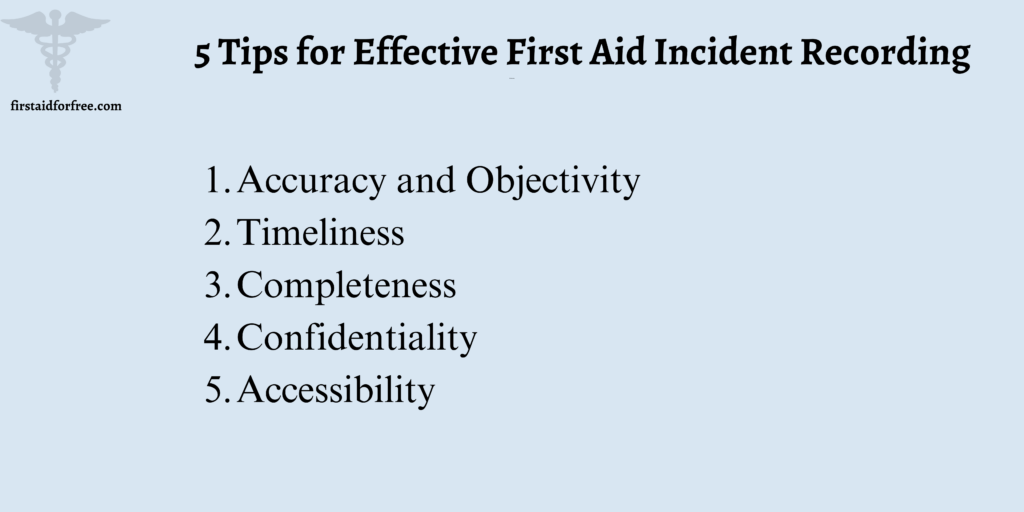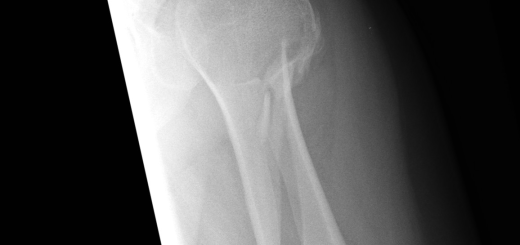Where Must First Aid Incidents Be Recorded: 5 Tips
Injuries and illness are not uncommon in a workspace, and they require immediate first aid.
You should be aware that those little first-aid moments might seem unimportant, but keeping track of them can actually be a big deal. In this blog post, we’ll explain why you should record first aid incidents, where to keep those records, and some easy tips for making sure you’ve got everything covered.
Why Record First Aid Incidents?

While administering first aid is crucial in any situation, accurately documenting those incidents is equally important. This mundane task offers a plethora of benefits, impacting everything from legal compliance to the well-being of those involved. Let’s dive deeper into the reasons why recording first aid incidents is essential:
- Legal Compliance: Different regions and industries have regulations mandating the recording of first aid incidents. These regulations serve to protect both employers and employees.
- Risk Management and Prevention: First aid incident records are a treasure trove of data when it comes to risk management. By meticulously recording details like the type of injury, location of the incident, and potential causes, organizations can identify patterns and trends. This allows them to proactively address recurring issues in their safety protocols.
- Medical Continuity of Care: Recording the details of the first aid provided, including the type of injury or illness and the treatment, helps medical professionals with crucial information. This continuity of care ensures the injured person receives the most appropriate follow-up treatment, potentially leading to faster recovery and better results.
- Insurance Claims: Accidents, no matter how minor, can sometimes lead to insurance claims. Whether an employee seeks workers’ compensation for a workplace injury or an individual files a claim under their health insurance, accurate first aid records can play a vital role.
- Quality Improvement in First Aid Practices: First aid records aren’t just about documenting incidents; they offer valuable feedback on the effectiveness of first aid practices within an organization. By reviewing these records, organizations can assess if their current first aid training and equipment are adequate.
Where to Record First Aid Incidents

When it comes to recording first aid incidents, understanding “where” to document them involves navigating two key aspects: legal mandates and best practices.
Legal Mandates
Every region and industry might have specific regulations stating where first-aid incidents must be recorded. These regulations aim to ensure a consistent system for documenting workplace accidents and illnesses. The two main categories are:
- Statutory Accident Books: In some countries, like the UK, with its RIDDOR (Reporting of Injuries, Diseases, and Dangerous Occurrences Regulations), specific types of workplace accidents and illnesses must be documented in a statutory accident book. These books have a required format and are often kept by the employer or designated safety officer.
- Work Safety Regulations: Many regions have broader work safety regulations that require employers to record all first aid incidents, regardless of severity. These records might not be mandatory reporting to authorities but are crucial for internal investigations and safety audits.
Finding Out Your Legal Requirements
Determining your specific legal requirements depends on your location and industry.
- Government Websites: Most government websites have sections on workplace health and safety that provide detailed information on accident reporting and record-keeping requirements.
- Safety Associations: National or regional safety associations can provide guidance and resources specific to your industry.
- Employer Handbook: If you’re an employee, your employer’s safety handbook or safety policy documents should summarize the process for recording first aid incidents.
Beyond Legal Requirements
Centralized System: Recording all first aid incidents in a single, designated location ensures consistency and promotes easy review and analysis. This could be a physical logbook kept in a central location or a digital database accessible to authorized personnel.
- Security and Access Control: First aid records often contain sensitive information about the injured person’s health. Implementing security measures to ensure that only authorized personnel can access the records is crucial.
- User-Friendly Format: The record-keeping system should be easy to understand and use. This encourages first responders to record incidents accurately and consistently.
Choosing the Right System
The ideal system depends on your specific needs and resources.
- Physical Logbooks: These are still widely used, particularly in smaller workplaces. They offer a simple, low-cost solution but can be difficult to analyze and store over long periods.
- Digital Databases: These offer a more organized and searchable system. They can be customized to include specific fields and also help with easier data analysis. However, they require initial investment and might have ongoing maintenance costs.
5 Tips for Effective First Aid Incident Recording

Recording a first aid incident isn’t just about jotting down a few basic details. Effective documentation requires a thorough approach, ensuring the record is accurate, complete, and serves its intended purpose. Some essential tips to remember:
1. Accuracy and Objectivity
The primary goal of any first aid record is to provide a factual account of the incident. You should avoid including opinions, judgments, or emotional reactions. Just focus on recording what happened, when it happened, and the details surrounding it. This objective approach ensures the record remains reliable and unbiased, even when reviewed later.
2. Timeliness
Memories fade with time. The sooner you record the details of a first aid incident, the more accurate and complete the record will be. Ideally, document the incident as soon as possible after it occurs while the details are still fresh in your mind. This reduces the risk of forgetting crucial information that could be helpful for future reference.
3. Completeness
Resist the urge to oversimplify the first aid record. Aim for completeness and capture all relevant details that might be helpful for future analysis or follow-up. This includes the date, time, and exact location of the incident, person Involved, nature of the incident, type of injury/illness, first aid provided, and if the injured person received further medical attention.
4. Confidentiality
First aid records often contain sensitive information about the injured person’s health. That’s why it’s crucial to maintain the privacy of all individuals involved in the incident. This means limiting access to the records to authorized persons only and avoiding sharing any personal information outside.
5. Accessibility
The information documented in first aid records should be easily accessible to those who need it. This means ensuring the records are stored in a secure but readily available location. For physical logbooks, consider storing them in a designated location Digital databases should have user-friendly interfaces and access control measures.
FAQs
Do I need to record first-aid incidents?
In many cases, yes. Local regulations might mandate recording all first-aid incidents or just specific types of injuries. It’s always best to check your local guidelines or with your employer’s safety department.
What information should I include in a first-aid record?
Focus on capturing the who, what, when, and where of the incident. Include details like the date, time, location, injured person’s name, type of injury, and first aid provided.
How long should I keep first aid records?
Retention periods vary depending on your location and industry. Generally, it’s recommended to keep records for several years to ensure accessibility for future reference or investigations.
Conclusion
We hope this article cleared your doubt and helped you understand the need to record first aid incidents and where they should be recorded.
Both employers and employees should ensure that safety is maintained within the workspace.





